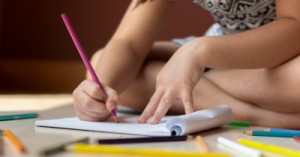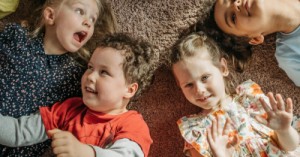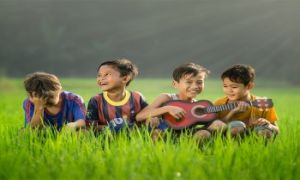When children feel safe, secure and supported they grow in confidence to explore and learn. In early childhood settings children develop a sense of belonging when they feel accepted, develop attachments and trust those that care for them. As children are developing their sense of identity, they explore different aspects of it (physical, social, emotional, spiritual, and cognitive), through their play and their relationships. The following article provides activities to promote each of the sub outcomes of EYLF Outcome 1: Children Have A Strong Sense Of Identity.
Activities To Promote EYLF Outcome 1
- 1.1 Children feel safe, secure and supported
Educators and services can implement this element by building secure attachments with children in their care through consistent and warm nurturing relationships. For example, when children arrive with their parents at the service, educators can greet them with a cheerful ‘hello’, introduce themselves using first names and ensure that the child and parents feel welcomed at the service. When children see educators not only welcoming them but their parents or primary caregivers too, the little ones are likelier to feel safe and better able to trust the service environment.
Another important way that educators can meet this Outcome Element is to acknowledge each child’s uniqueness in positive ways. This means spending time with a child to find out their likes and interests and accordingly design learning experiences; so even if the majority of children in your class or room may love to read picture books or listen to stories with you, there might be a child or two with a more tactile sense of learning. Encourage them to dabble with paint and glue or make story props with beads, yarn, clay, string, fabric and cardboard as you read stories or show a video to others.
An important aspect of Element 1.1 is to support children during feelings of distress, fear or discomfort while recognising that may take some time to resolve. So if a child experiences distress at being separated from parents, use orientation visits that allow parents to remain for a while with the child at the centre. See if your service can adopt a primary carer system where each child is allocated to a particular educator who is the key person to support the child and family especially during the orientation period and on arrival each day. No matter what practices are adopted, educators need to be patient and understanding as each child is different and thus will experience separation differently.
- 1.2 Children develop their emerging autonomy, inter-dependence, resilience and sense of agency
Educators and services can meet this Learning Outcome element by providing time and space for children to engage in both individual and collaborative pursuits. This will involve planning the day that offers a mix of high and low energy, social and independent activities. For example, you could alternative a high-energy activity like a rhyme session, dramatic play or nature walk with one that allows children to unwind like playing with crayons or reading a story on their own.
One of the most important ways children can develop a sense of agency is by being allowed to make choices and decisions – which are not only be related to learning experiences, like they are asked, “Do you want to paint with crayons or paints” but which lets them exercise control over some aspects of their daily lives, like, “Do you want to have a nap first or your afternoon snack?”. However, children need to be presented only with choices that adults can agree to. In order to make this happen, limit choices to two or three options. So rather than asking a child if they want to do the Math activity – to which they can say ‘No’ – ask whether they would like to do the counting or the sorting activity. If both need to be completed before the end of the day, ask her which would she like to do first?
The above learning outcome element also highlights the need for children to be aware of their own rights as well as of the needs and rights of others. So when children are playing, make sure you have enough duplicates of popular toys which will make it easier to teach children to share. At the same time, if there is someone taking away toys from another child, talk to them about how it might make them feel if you take a toy off them while they are still playing with it.
- 1.3 Children develop knowledgeable and confident self-identities.
Educators can meet this outcome by ensuring that all children experience pride and confidence in their achievements; so, when a child makes a drawing or completes a block tower, go and see what it is; ask questions about it and celebrate their excitement. When the family comes to pick up the child, share their achievement and show photos so that the children feel proud of their contributions.
One of the most significant ways that children can be supported in building knowledgeable and confident self-identities is by promoting in them a strong sense of who they are and their connectedness to others – a shared identity as Australians. You can do this by putting up photos of the children in your centre or preschool accompanied by the Aboriginal or Torres Strait Islander flag. Look for ways that family members or community Elders can be invited to share child-rearing practices from their culture, like singing, dancing and narrating Dreamtime stories. Educators can also encourage children to talk in the language they speak at home while they are playing.
- 1.4 Children learn to interact in relation to others with care, empathy and respect.
Educators can meet this learning outcome element by building including during the day moments of one-to-one interactions with children, particularly babies and toddlers. An excellent way to do this is through daily routines like nappy changes for toddlers or feeding time for babies. Such one-to-one nurturing interactions help to build secure attachments for children, making them in turn capable of showing caring interest to other children.
To meet all aspects of this learning outcome element, it is necessary for educators to recognise children’s complex relationships and sensitively intervene in ways that promote consideration of alternative perspectives and social inclusion. So for example, if there is a child who exhibits disruptive behaviours when asked to join small group activities and just wants to be with a doll or their ‘baby’, an educator might look for ways to encourage the child to be more interactive even while caring for the ‘baby’ – this can be done by talking about child-rearing practices in Africa and some other cultures in which mothers strap their babies to their backs with a shawl. Such an intervention would not only help the child engage more with the other children during group activities, thereby promoting the child’s sense of belonging, but also strengthen their own sense of wellbeing by giving them a reason to better regulate their behaviour and emotions.
One of the most effective ways that educators can meet this Learning Outcome element, is by modelling care, empathy and respect for children, staff and families through their own words and actions. So if a child is acting up in your class, instead of showing frustration or distress, reach out in a calm and understanding manner. Also when you interact with other staff like cooks and servers in the service, ensure that your behaviour is empathetic and respectful so that children in your care also learn how to behave with others.
Further Reading:
The EYLF is a guide that consists of Principles, Practices and 5 main Learning Outcomes along with each of their sub outcomes, based on identity, community, wellbeing, learning and communication. For more information: Understanding EYLF
Within the Early Years Learning Framework, there are three basic concepts that children’s lives are characterized by. Belonging, Being and Becoming. For more information, please read the following: Belonging, Being & Becoming Concepts Of The EYLF
The EYLF Learning Outcomes are goals that can be achieved by a child during their learning. The outcomes and sub outcomes cover a variety of areas which include identity, community, wellbeing, learning and communication. For more information, please read the following: EYLF Learning Outcomes
The following article provides information on each of the 5 Principles and examples of strategies of how to implement the eylf principles into your service. For more information, please read the following: EYLF Principles And Strategies To Implement Them
The following article provides information on each of the 8 Practices and examples of how to implement the eylf practices into your service. For more information: EYLF Practices And Strategies To Implement Them
A guide for educators on what to observe under each sub learning outcome from the EYLF Framework, when a child is engaged in play and learning. For more information, please read the following: How Children Can Achieve EYLF Learning Outcomes
To support children achieve learning outcomes from the EYLF Framework, the following list gives educators examples of how to help children with their goals. For more information, please read the following: How Educators Can Promote EYLF Learning Outcomes
References:
- Belonging, Being and Becoming EYLF For Australia, ACECQA
- Educators' Guide To The EYLF , ACECQA







 Here is the list of the EYLF Learning Outcomes that you can use as a guide or reference for your documentation and planning. The EYLF
Here is the list of the EYLF Learning Outcomes that you can use as a guide or reference for your documentation and planning. The EYLF The EYLF is a guide which consists of Principles, Practices and 5 main Learning Outcomes along with each of their sub outcomes, based on identity,
The EYLF is a guide which consists of Principles, Practices and 5 main Learning Outcomes along with each of their sub outcomes, based on identity, This is a guide on How to Write a Learning Story. It provides information on What Is A Learning Story, Writing A Learning Story, Sample
This is a guide on How to Write a Learning Story. It provides information on What Is A Learning Story, Writing A Learning Story, Sample One of the most important types of documentation methods that educators needs to be familiar with are “observations”. Observations are crucial for all early childhood
One of the most important types of documentation methods that educators needs to be familiar with are “observations”. Observations are crucial for all early childhood To support children achieve learning outcomes from the EYLF Framework, the following list gives educators examples of how to promote children's learning in each individual
To support children achieve learning outcomes from the EYLF Framework, the following list gives educators examples of how to promote children's learning in each individual Reflective practice is learning from everyday situations and issues and concerns that arise which form part of our daily routine while working in an early
Reflective practice is learning from everyday situations and issues and concerns that arise which form part of our daily routine while working in an early Within Australia, Programming and Planning is reflected and supported by the Early Years Learning Framework. Educators within early childhood settings, use the EYLF to guide
Within Australia, Programming and Planning is reflected and supported by the Early Years Learning Framework. Educators within early childhood settings, use the EYLF to guide When observing children, it's important that we use a range of different observation methods from running records, learning stories to photographs and work samples. Using
When observing children, it's important that we use a range of different observation methods from running records, learning stories to photographs and work samples. Using This is a guide for educators on what to observe under each sub learning outcome from the EYLF Framework, when a child is engaged in
This is a guide for educators on what to observe under each sub learning outcome from the EYLF Framework, when a child is engaged in The Early Years Learning Framework describes the curriculum as “all the interactions, experiences, activities, routines and events, planned and unplanned, that occur in an environment
The Early Years Learning Framework describes the curriculum as “all the interactions, experiences, activities, routines and events, planned and unplanned, that occur in an environment


